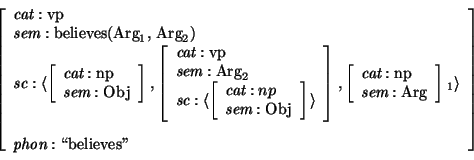
will be something like
Although I have argued that the heads first approach usually implies, that the logical form of a node is sufficiently instantiated at the time this node has to be generated, it is possible to write linguistically motivated grammars, where this is not the case. For example, raising-to-object constructions in English can be analyzed in a way, that is problematic for BUG. Assume that the semantic structure for the sentence

will be something like
![]()
Furthermore assume that
Bob is the syntactic object of believes. A reasonable
definition (inspired by the LFG treatment of such cases) of the
lexical entry believes in the spirit of the preceding Dutch
example grammar then is the following:

This lexical entry has, apart from its subject, two complements, a
noun phrase and a verb phrase. Furthermore it is stated that the
logical form of the noun phrase is identical to the logical form of
the subject of the embedded verb phrase.
However, the previous analysis of raising-to-object constructions is problematic for BUG. Because the generator proceeds bottom-up it will try to generate the object noun phrase, before the embedded verb phrase has been generated, i.e., before the link between the embedded subject and the object is found. As a result, the logical form of the object is not yet instantiated, and therefore BUG may not terminate in this case, or at least waste much effort searching for all kinds of NP's that later turn out to be not the right ones. Assuming that the analysis of raising-to-object is correct, then it might be necessary to augment BUG with some version of goal freezing. If the generator comes across an un-instantiated logical form, then the execution of that node is suspended until the logical form is instantiated. In the case of believes, this will imply that the embedded verb phrase will be generated first, after which the object can be generated.
On the other hand, it has also been argued that the order in which the
two objects of believe are selected is exactly the other way
around as in the definition above. In [8] it is
argued, that the verb phrase is selected before the NP
object. Such an analysis can be motivated by observing that certain
constraints on control, reflexivization and passive, are easily explained using
the notion `obliqueness', which in our example grammar is implemented
as an ordering on the elements of the subcat list (see also
[28]). This analysis is only available in formalisms
that provide for wrapping operations. Note that, if indeed the
noun phrase object is selected after the verb phrase, no problem for
BUG arises. In the next chapter we propose the use of more powerful
string operations, such as wrapping. In such an extended formalism it
is thus possible to analyze raising-to-object constructions such that
it is not necessary to extend BUG with a dynamic computation rule as
discussed above.